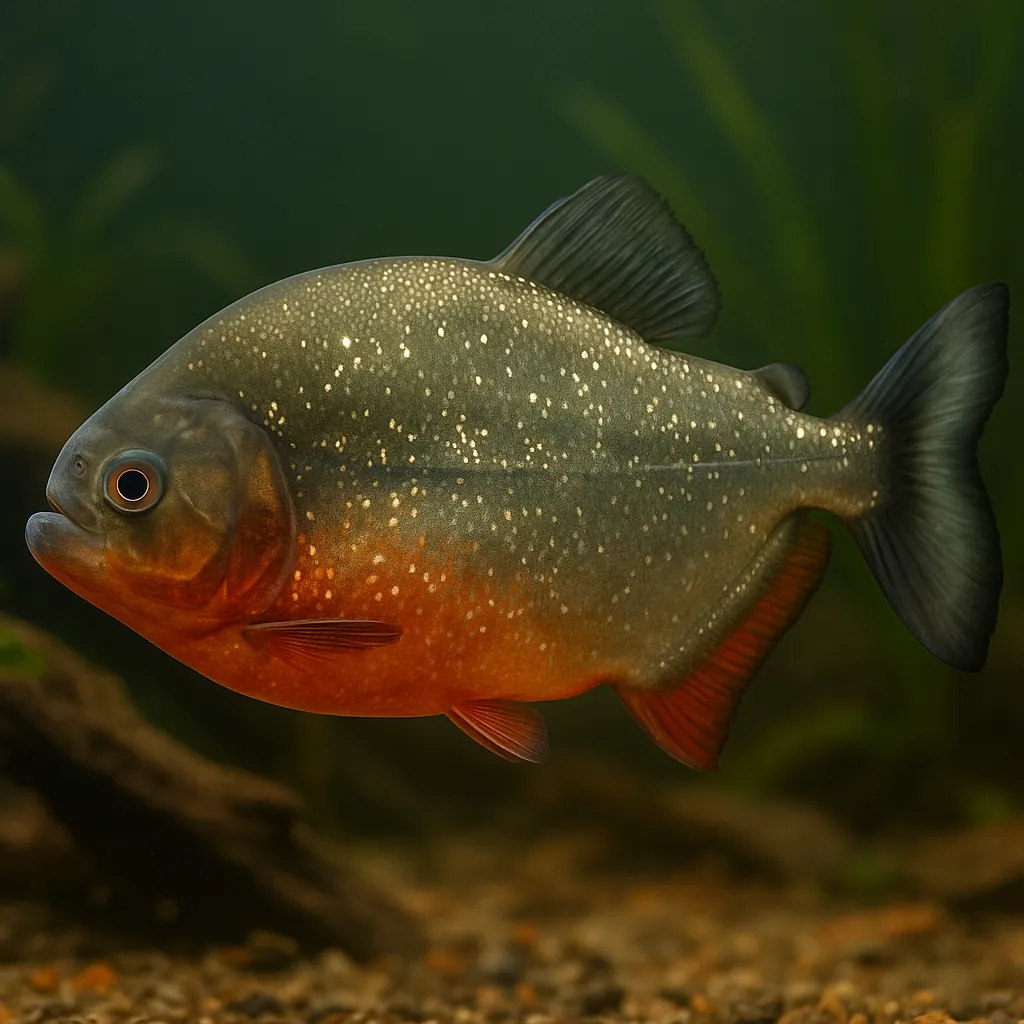
Red bellied piranha
Introduction
The Red-bellied Piranha (Pygocentrus nattereri) is a captivating freshwater fish renowned for its distinctive red underbelly and formidable reputation. Despite their fearsome image, these fish have intrigued aquarists with their unique behaviors and striking appearance. However, keeping Red-bellied Piranhas requires careful consideration due to their specific care needs and natural tendencies.
Are Red-bellied Piranhas suitable for beginner aquarists?
While their allure is undeniable, Red-bellied Piranhas are best suited for aquarists with some experience, as they demand precise care and a well-maintained environment.
What makes Red-bellied Piranhas appealing to fishkeepers?
Their vibrant coloration, intriguing behaviors, and the challenge they present in care make them a fascinating addition for dedicated hobbyists.
Care and Environment
Proper care for Red-bellied Piranhas involves replicating their natural habitat and meeting their specific requirements to ensure their health and well-being.
What is the minimum tank size for a Red-bellied Piranha?
A single Red-bellied Piranha requires a minimum tank size of 284 liters (75 gallons) to provide adequate space and reduce stress.
What are the ideal water parameters for Red-bellied Piranhas?
Maintain a temperature between 24°C and 28°C (75°F to 82°F), a pH level of 6.0 to 7.5, and water hardness between 4 to 18°N (71.43 to 321.43 ppm) to mimic their natural conditions.
How should the tank be set up for Red-bellied Piranhas?
Incorporate hiding spots using driftwood, rocks, and dense vegetation to create a natural environment. Ensure the tank has subdued lighting, as bright lights can cause stress. A sandy substrate is recommended to replicate their native riverbeds.
What filtration system is suitable for Red-bellied Piranhas?
Due to their messy eating habits, a robust filtration system is essential to maintain water quality. Regular water changes and powerful filtration help manage waste and prevent the buildup of harmful substances.
What should be included in a Red-bellied Piranha's diet?
Offer a varied diet consisting of live or frozen fish, prawns, earthworms, and high-quality carnivorous pellets. Avoid feeding them mammalian meats like chicken or beef, as these can be harmful to their health.
Are there any specific challenges in keeping Red-bellied Piranhas?
They can be sensitive to changes in their environment and may exhibit aggression, especially during feeding times or when stressed. It's crucial to monitor their behavior and maintain stable tank conditions.
Origin and Habitat
Red-bellied Piranhas are native to the freshwater rivers and lakes of South America, including the Amazon Basin, Rio Paraguay, and Rio Paraná. They inhabit a variety of water bodies such as open water channels, small tributaries, shallow backwaters, oxbows, and temporary forest pools created during the rainy season. These environments are typically characterized by warm temperatures, soft and slightly acidic water, and abundant vegetation, providing ample hiding spots and hunting grounds.
What type of water bodies do Red-bellied Piranhas inhabit?
They are found in diverse freshwater environments, including rivers, lakes, and floodplains, often preferring areas with dense vegetation and slow-moving waters.
How do seasonal changes affect their habitat?
During the rainy season, they may move into flooded forest areas, taking advantage of the increased availability of food and shelter.
Temperament and Compatibility
Red-bellied Piranhas are known for their aggressive and territorial nature, especially during feeding times or when stressed. They are shoaling fish and thrive when kept in groups, which can help reduce individual aggression. However, their predatory instincts make them unsuitable for most community tanks.
Can Red-bellied Piranhas be kept with other fish species?
Due to their aggressive tendencies, it's generally recommended to keep them in a species-only tank. If tank mates are desired, choose large, robust fish capable of defending themselves, such as Pacus or Silver Dollars, and ensure the tank is spacious enough to minimize conflicts.
How many Red-bellied Piranhas should be kept together?
Keeping them in groups of at least four can help establish a hierarchy and reduce aggression among individuals.
What behaviors indicate stress or aggression in Red-bellied Piranhas?
Signs include fin nipping, chasing, and hiding. Monitoring their behavior closely can help in making necessary adjustments to their environment.
Interesting Facts
Red-bellied Piranhas have a reputation that often overshadows their true nature. In the wild, they are opportunistic feeders, consuming a diet that includes fish, insects, crustaceans, and plant matter. They are also known for their strong parental instincts, guarding their eggs and fry diligently. Despite their fearsome image, they can be quite timid in captivity, often hiding when approached.
Do Red-bellied Piranhas only eat meat?
No, they are omnivorous and consume a variety of foods, including plant material, in their natural habitat.
How do Red-bellied Piranhas care for their young?
They exhibit strong parental instincts, with both parents guarding the nest and protecting the eggs until they hatch.
Are Red-bellied Piranhas as dangerous as commonly portrayed?
While they have sharp teeth and can be aggressive, they are generally not a threat to humans unless provoked or mishandled.
Sources
All information in this article has been gathered from the following reputable sources:
Overview
Recommended Tank Size 132.1 Gallons (for groups of 6 or more) |
Minimum Group Size 4 |
Minimum Tank Volume 75 Gallons |
Maximum Adult Length 12 inches |
Average Adult Length 7.9 inches |
Shoaling (6+ required) Yes |
Preferred Water Type Freshwater, soft, slightly acidic |
Temperature Range (°C) 24–28 |
pH Range 6.0–7.5 |
Water Hardness (dGH) 4–18 |
Typical Lifespan (years) 10 years |